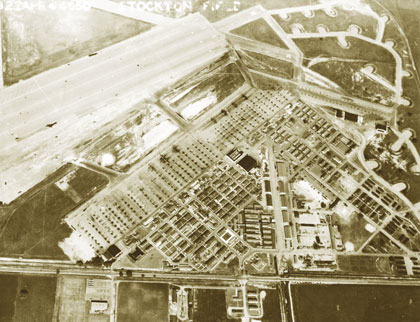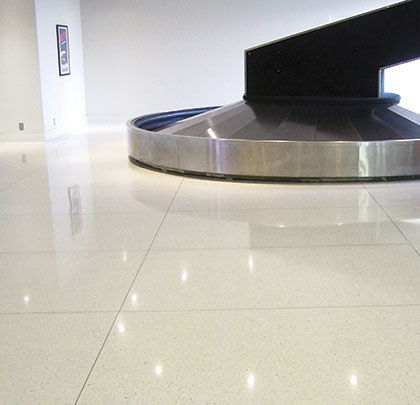While many may not yet be familiar with the Stockton Metropolitan Airport, it offers what people want most, ease of travel. It’s conveniently located between Interstate 5 and State Highway 99, in the city of Stockton, California. The open-lot parking facility is located just 50 feet from the terminal, offering low cost, automated parking. Inside the terminal is a full service restaurant with both indoor and outdoor dining. Reminiscent of airports past, travelers can enjoy their pre-flight time with family or business associates, right up to their departure. Small enough to achieve “personal” service, and loaded with the modern amenities we’ve come to expect, Stockton Metropolitan Airport is by far the friendliest air travel for the Central Valley. Newly renovated, bright and modern, hassel-free, (SCK) flight schedules are planned to grow at a rapid pace to meet the public demand for Central Valley convenient air travel access.
In the fall of 2013, a chance encounter between Harry Mavrogenes, interim airport director of Stockton Metropolitan Airport, and Bill Fields, floor specialist and president of Surtec, Inc., (a local chemical manufacturer) resulted in a partnership of restoration. They discussed the airport’s desperate need of a cosmetic overhaul and complete replacement of the Terminal Building carpet was being considered.
Upon inspection, a discovery was made, under the stained and worn carpet tiles laid a once gorgeous “real” terrazzo floor. This propelled the prospect of restoration of the terrazzo floor, rather than replacement of the carpet. Stripping and polishing tests were conducted and the decision was made to restore the original terrazzo floor, saving thousands of tax dollars. Surtec, in cooperation with local contractor, DCS Facility Services, began the process of restoration.

Featured Image: The result is a renewed natural beauty that reflects light and provides safety tested slip and stain resistance with a low maintenance finish—restoration long overdue for an airport with such rich American history.
Above: Stockton Field, WWII, photo courtesy of www.twinbeech.com.
THE EARLY YEARS
Gold was discovered on the American River in early 1848, transforming Stockton from a small settlement into a thriving commercial center. The city was officially founded in 1849 by German immigrant Charles M. Weber, when he purchased 49,000 acres of land. Early settlers included gold seekers from around the globe. The name Stockton was given to honor Commodore Robert Stockton.
After the gold rush, shipbuilding became the main industry of the area until agriculture took the lead near the end of the 1800’s. By the early 1900’s the railroad began laying tracks to the area as it was forecasted to become a substantial hub. This solidified Stockton’s stance as an agricultural hub of the entire nation.
In 1925, the first flier landed at what is now Stockton Metropolitan Airport. In 1927, the small airfield was converted by the City of Stockton to handle increasing Army air traffic. During those early years, much land was acquired for expansion, adding roadways, wells and pumps, taxiways, lighting, and fencing. On May 7, 1927, Stockton Municipal Airport became the field’s name and the city held a dedication ceremony that included the first air show. By 1928, the U.S. Army used Stockton Municipal Airport as a “gas stop” during training flights throughout the state.
ARMY OPERATES AIRBASE
The U.S. Army, City of Stockton, and the County of San Joaquin entered into a lease agreement on August 15, 1940, for the Federal Government (Army) to operate an airbase for one dollar per year from 1940 to 1965. At that time, the County of San Joaquin partnered with the City of Stockton to help absorb costs and share responsibility. On January 11, 1941, the Army held a dedication ceremony, when Stockton Field became the official name of the Airport.
The Army took command of the field and began building an advanced pilot training school, initially garrisoned by the 68th Air Base Group (Special) under the Air Corps Advance Flying School. On January 2, 1942, flight instruction began with a class of 93 cadets. Stockton Field would become the largest advanced pilot training base in the West. The last group of cadets to graduate was on March 2, 1945.
Many of the graduates went on to become decorated “Aces” of WWII. Most notable, were eleven of the thirty-six pilots who participated with General “Jimmy” Doolittle on his historic raid over Tokyo on April 18, 1942. Another to call Stockton Airfield his Alma mater was Lt. Thomas Lanphier, who shot down Admiral Yamamoto’s plane in the Pacific during the battle of New Guinea. Admiral Yamamoto was the chief architect responsible for planning the surprise raid on Pearl Harbor, December 7, 1941.
In August of 1946, after the end of World War II, the Federal Government announced the return of the airfield to the City of Stockton and the County of San Joaquin, who would again take joint ownership.
CITY AND COUNTY RESUME OPERATION
The City of Stockton and the County of San Joaquin resumed operating the former Stockton Municipal Airport in December 1946 under a joint (interim) license. There were approximately 175 buildings, including 50 airport-related structures. The buildings were primarily the Quartermaster 700-series and 800-series type construction with concrete foundations, wood floor, composition roof, and wood lap siding. On July 1, 1946, United Airlines began its first scheduled service from Stockton to Los Angeles and San Francisco with DC-3 aircraft. In 1948, the U.S. Army, with exception of the Sharp Annex, left the field and officially dedicated the Airport back to civil use with the city and county assuming administration. Sole ownership was transferred to the county on July 1, 1956.
Throughout the 1950’s and 60’s the airport grew steadily, commercial passenger airliners including United, Frontier, and Southwest had flights there. On July 11, 1964, Stockton Municipal Airport was officially renamed the Stockton Metropolitan Airport, reflecting its changing role as a civil airport.
By the 1970’s nearly 300,000 passengers used Stockton airport annually. Commercial passenger carriers came and went over the next three decades. There were no commercial passenger flights from 2003 until 2006 when Allegiant Air began round trip service to Las Vegas. In 2014, Allegiant Air remains, offering limited flight schedules to Honolulu, Las Vegas, Phoenix/Mesa, and Scottsdale. ■
For More Information: For more information on this project or other restorations, contact Surtec, Inc. at 800.877.6330, or via email moneil@surtecsystem.com.
_________________________________________________________________________
Modern Contractor Solutions, Buyers Guide – November 2015
Did you enjoy this article?
Subscribe to the FREE Digital Edition of Modern Contractor Solutions magazine.

Restoring the Terrazzo


